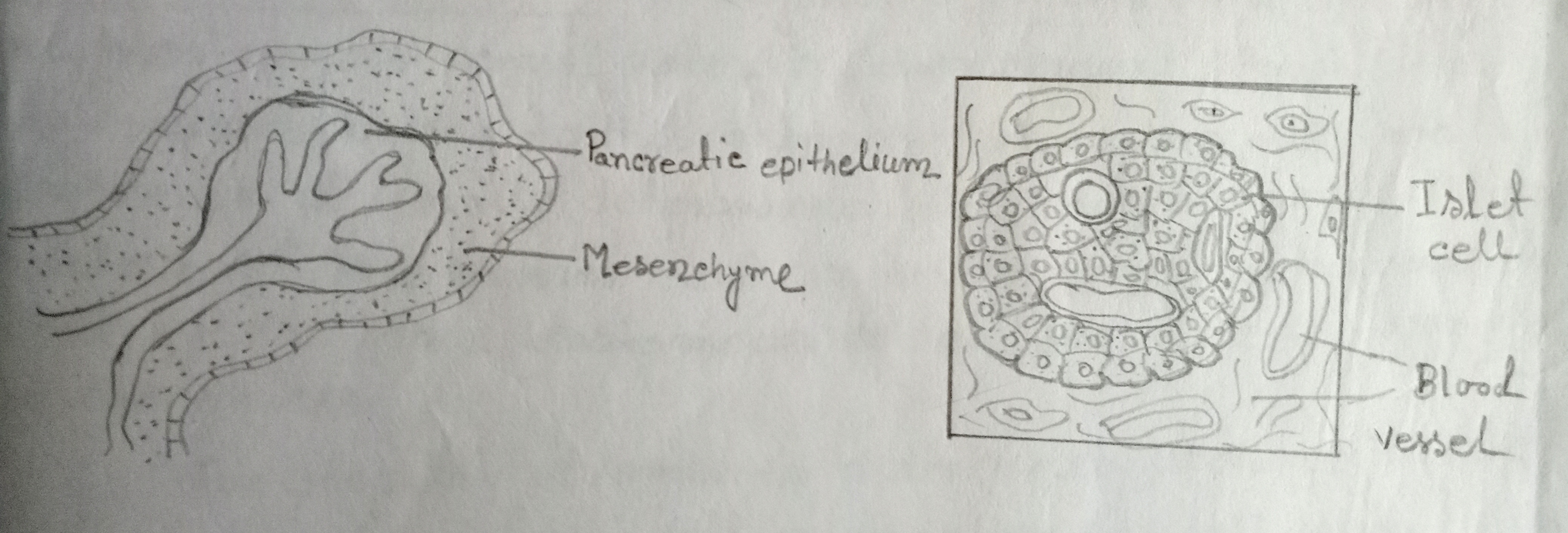Explain difference between Instructive & permissive interactions, Mosaic & regulatory embryos, Radial & spiral cleavage, Regeneration & embryonic development.
(i) Instructive & permissive interactions in differentiation of tissue
Instructive interaction:- In instructive interaction, the inducing tissue gives instruction to commit cells to a specific pathway of development.
Example:- The interaction between the mesenchyme & the epithelial ectoderm is an example of instructive interaction.

Fig: Regional specificity of induction
When cells of the dermis (mesoderm) are recombined with the epidermis (ectoderm) in the chick, the type of cutaneous structure made by the electron is determined by the original location of the mesoderm.
Permissive interaction:- In permissive interaction, the inducing tissue provides signals to an already committed responding tissue to commence differentiation.
Example:- Development of pancreas depends on the associated mesoderm. In a 9-day old embryo, the pancreatic mesoderm & ectoderm are separated from one another, there will not be any further development. But if they are recombined in a culture medium, both exocrine & endocrine cells differentiate normally. Also, instead of the pancreatic mesenchyme, if the mesenchyme from other regions such as mesenchyme from salivary gland region is substituted normal pancreatic cells still differentiate. Somites which produce muscles & cartilage cells can also induce pancreatic endoderm to develop normally. Even extracts of the embryo can induce the pancreatic endoderm. All these results suggest that by the 9th day of the embryonic life of a mouse, the pancreatic endoderm is already determined & only a non-specific signal from mesoderm is sufficient for it to complete the development. The mesoderm can be from any region but must be in proximity to the endoderm. It is such interactions is the example of permissive interaction.

Fig: Development of pancreas in a mammal
(ii) Mosaic & regulatory embryos
Eggs, as well as clearly cleavage embryos, are sometimes divided into two groups: (a) mosaic embryos & (b) regulative embryos. The terms mosaic & regulative relate to the time at which the restrictions in development are imposed on the blastomeres. For example:
Mosaic embryos:- The embryos of lunicates belong to mosaic or determinate category. In these organisms, the various blastomeres become restricted to form only specific structures as soon as they are formed or during the first few cleavage. In other words, the respective fates of different blastomeres are finally determined early in mosaic embryos. As a result, the removal or loss of certain blastomeres cannot be compensated by the other blastomeres & the embryos will be defective in a structure which is normally derived from the missing blastomeres.
The mosaic embryos depend upon ooplasmic determinants, that is, intrinsic factors for cell fate determination.
Regulative embryos:- Regulative embryos the restrictions on blastomeres occur later in development. Amphibians & sea-urchins belong to this category. Since the cell fate of blastomeres is finally determined later, any removal or destruction of blastomeres early in development can be compensated by the other blastomeres which are able to form all the structures.
The regulative embryos mainly rely upon extrinsic factors derived from cell interaction for cell determination.
(iii) Difference between radial & spiral cleavage
Radial cleavage:- If each of the blastomeres of upper tier lies exactly over the corresponding blastomere of the lower tier the pattern of cleavage is radially symmetrical i.e, blastomeres are arranged along the radii of the sphere, e.g, echinoderms, amphioxus, amphibians.

Fig: Radial arrangement of blastomeres
Spiral cleavage:- The upper tier of blastomeres of 8-cell stage embryo may be shifted with respect to the lower tier so that radially symmetrical arrangement of blastomeres is distorted in various degree. In such a case the blastomeres of the upper tier do not lie exactly over the corresponding blastomeres of the lower tier. Instead, all the blastomeres of upper tier are shifted in the same direction with respect to all the blastomeres of the lower tier, e.g, annelids, mollusks.

Fig: Spiral cleavage in mollusc snails
(iv)Difference between regeneration & embryonic development
There are important differences between regeneration & embryonic development. Regeneration in multicellular animals does not begin from a totipotent single egg cell but from a group of cells recruited from the tissues of the functioning body of an organism. Cells participating in regeneration may not be even pluripotent if no reserve of undifferentiated cells is available. Regeneration may involve initial growth by the proliferation of these cells to form a bud or blastema.
The process of regeneration is influenced by the systemic factors (nerves, hormones) & physiological conditions of the organism, whereas embryonic development is free from such influences.
At a fundamental level, both regeneration & embryonic development are epigenetic processes, involving gene expression & programming. And both require an external stimulus to begin; it is the penetration of the sperm into the egg (fertilization) in the case of embryogenesis & injury (accidental or intentional) in the case of regeneration.